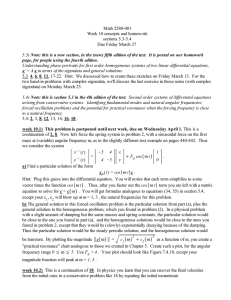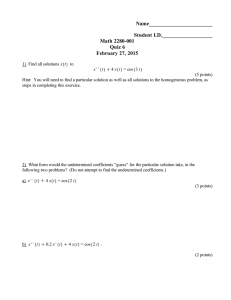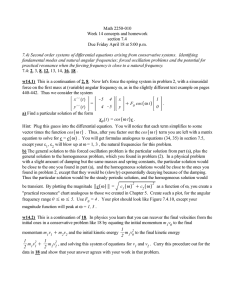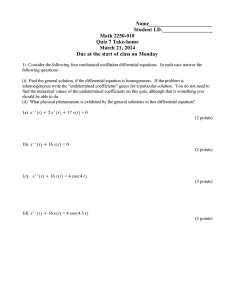Math 2250-010 Lab 14
advertisement
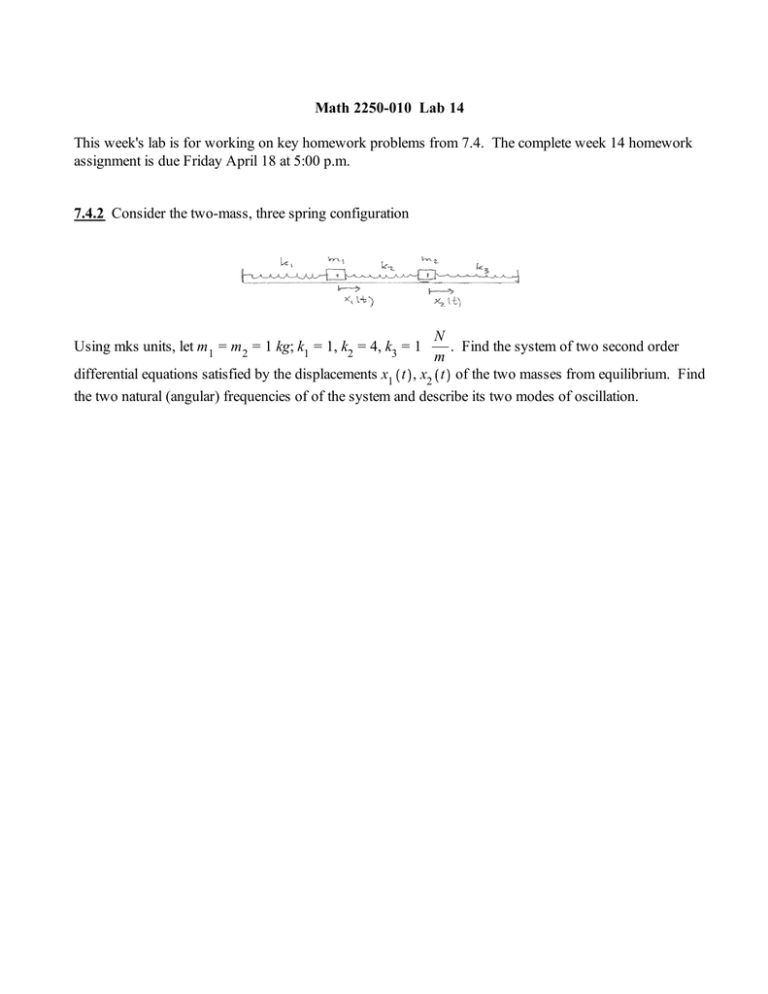
Math 2250-010 Lab 14 This week's lab is for working on key homework problems from 7.4. The complete week 14 homework assignment is due Friday April 18 at 5:00 p.m. 7.4.2 Consider the two-mass, three spring configuration N . Find the system of two second order m differential equations satisfied by the displacements x1 t , x2 t of the two masses from equilibrium. Find the two natural (angular) frequencies of of the system and describe its two modes of oscillation. Using mks units, let m1 = m2 = 1 kg; k1 = 1, k2 = 4, k3 = 1 7.4.8a) Now let's force just the first mass in the mass-spring system of 7.4.2, with F1 t = 96 cos 5 t (and with F2 t = 0 i.e. no external force on the second mass.) Verify that this leads to the inhomogeneous second order system of differential equations: x1 ## t x1 K5 4 96 = C cos 5 t . x2 ## t 4 K5 x2 0 7.4.8b) Find an undetermined coefficients particular solution to the system above, of the form xP t = cos 5 t c . Hint: Plug this "undetermined coefficients" guess into the differential equation. You will notice that each term simplifies to some vector times the function cos 5 t . Thus, after you factor out the cos 5 t term you are left with a matrix equation to solve for c. (The matrix equation should be equivalent to equation (32) in the text, which we also worked out in class on Wednesday, namely 2 A C w I c =KF0 with the value w = 5.) 7.4.8c) Use x = xP C xH to solve the initial value problem x1 ## t x2 ## t = 4 x1 4 K5 x2 K5 C cos 5 t 96 0 x1 0 = 0, x1 # 0 = 0 x2 0 = 0, x2 # 0 = 0. Your solution should be a superposition of three oscillations at different frequencies - two that correspond to the two fundamental modes of the unforced system, and one that is oscillating at the same frequency as the forcing function. w14.1) This is a continuation of 2, 8. Now let's force the spring system in problem 2, with a sinusoidal force on the first mass at (variable) angular frequency w, as in the slightly different text and Wednesday class note examples. Thus we consider the system x## t K5 4 x 1 = C F0 cos w t . y## t 4 K5 y 0 a) Find a particular solution of the form xP t = cos w t c . Hint: Plug this guess into the differential equation. You will notice that each term simplifies to some vector times the function cos w t . Thus, after you factor out the cos w t term you are left with a matrix equation to solve for c = c w . You will get formulas analogous to equations (34, 35) in section 7.5, except your c1 , c2 will blow up at w = 1, 3 , the natural frequencies for this problem. b) The general solution to this forced oscillation problem is the particular solution from part (a), plus the general solution to the homogeneous problem, which you found in problem (2). In a physical problem with a slight amount of damping but the same masses and spring constants, the particular solution would be close to the one you found in part (a), and the homogeneous solutions would be close to the ones you found in problem 2, except that they would be (slowly) exponentially decaying because of the damping. Thus the particular solution would be the steady periodic solution, and the homogeneous solution would 2 2 be transient. By plotting the magnitude c w = c1 w C c2 w as a function of w, you create a "practical resonance" graph analogous to those we created in Chapter 5. Create such a plot, for the angular frequency range 0 % w % 5. Use F0 = 4 . Your plot should look like Figure 7.4.10, except your magnitude function will peak at w = 1, 3 . We discussed a similar example at the end of class on Wednesday.


